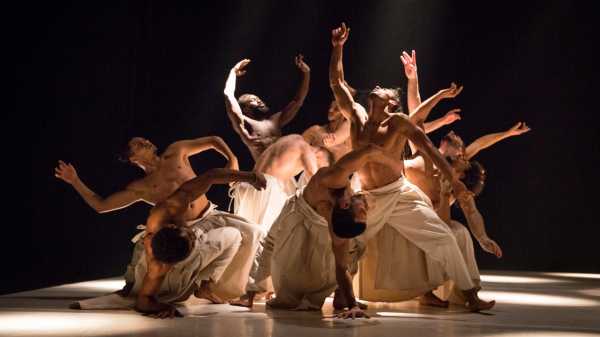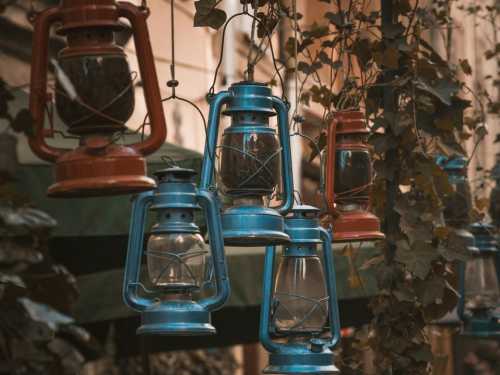
The thirteen men in the Compagnie Hervé Koubi look more like wrestlers
than like members of a conventional contemporary-dance company, with bulky
muscles, rounded backs, and a relaxed, lumbering way of moving that
brings to mind the locker room. Before a recent rehearsal at the Joyce,
where the company is performing through Sunday, they ambled on, in ones
and twos, pausing to chat with a hand on the shoulder, whispering in
Arabic or French, or dropping down to do a few pushups. Koubi likes to
refer to them as “l’équipe,” his team. Most are from Algeria, with a
couple from Morocco, one Frenchman, and a single man from Burkina Faso.
You soon see those muscles put to use in “What the Day Owes to the
Night,” the piece they’re performing at the Joyce. About an hour long,
it is both quiet and astonishing. The dancers, clad in long white skirts
and bare from the waist up, do things onstage that look impossible, even
dangerous. They spin on one arm, then switch to the other. They dive
horizontally and flip over in midair, like a pancake being flipped on a
griddle, or up and up, drawing a steep and elegant arc. The most
gasp-inducing move, perhaps, is when one man crawls up his comrades’
backs, calmly stands up, and then falls backward, blindly, into a moving
pack of hands. Each time it happens, you feel like you’re falling, too.
The movement is not only exciting but beautiful. The men look like
figures in an etching by William Blake, like falling angels or Icarus
after flapping his wings too close to the sun.
The allusion to images from Western art is not accidental. Hervé Koubi,
the French-born company director and choreographer of “What the Day Owes
to the Night,” has said that he was inspired, in part, by the
Orientalist paintings of Eugène Delacroix, who travelled to North
Africa, in 1832, as part of group of French colonial officials.
Delacroix became obsessed with the region, seeing it, through his French
Romantic eyes, as a kind of “living antiquity.” That vision is, of
course, tinged by colonialism, of which Koubi is well aware. “It is a
dark area in our history, but we have to take responsibility for that,
it’s part of us,” he said during a break in rehearsal, using the French
verb assumer, for which there is no good English translation. (The
meaning lies somewhere between “accept” and “take on.”)
What’s interesting is that Koubi both identifies with the men in his
company and regards them with a certain distance. He is first-generation
French, of Algerian descent, but speaks no Arabic. (His choreographic
assistant Fayçal Hamlat sometimes translates for him.) Koubi’s parents
came to France as adults, bringing with them his elder sisters. But, as
he put it, “When they left, they left for good.” For the first
twenty-five years of his life, he had no connection to the place they had
come from. (In this, his story echoes that of the protagonist of Yasmina
Khadra’s novel “Ce Que le Jour Doit à la Nuit,” which inspired the title
of Koubi’s piece.)
His mother, who had been rejected by her Muslim family for refusing an
arranged marriage, changed her name from Safia to Colette—was there ever
a name more French? His Jewish father seldom spoke of his own family.
They named their French-born son Hervé. At home, they spoke only French,
except, as Koubi pointed out, when they were arguing. His upbringing was
completely laïque (secular)—nonreligious, happy, culturally
well-adjusted. He studied pharmacology at university, to please his
parents, and dance, to please himself. In a country where the very
French Revolutionary concept of secularity (laïcité) has sometimes
complicated, rather than facilitated, the integration of immigrants from
the former colonies, Koubi represented a case of near-seamless
transplantation.
Even so, as he said, “One can’t completely divorce oneself from the
past.” In 2009, at the age of twenty-five, Koubi felt compelled to
travel to Algeria and explore the missing half of his identity. He had
hoped that his parents would come with him, but they kept offering up
excuses. This was a trip he had to make on his own. Like Delacroix, he
said, he was exploring the Orient of his imagination, “The country of my
origins, where I could have been born, of which my father sometimes
spoke.”
As a trained dancer and choreographer, his way of processing the
encounter was through dance. He held auditions in Algeria, not easy in a
country where, at least at the time, there were no dance studios or
companies. Instead, Koubi said, there are groups of men who train
themselves by imitating YouTube videos and each other in the arts of
hip-hop and the Brazilian martial-arts-cum-dance-form capoeira. It
speaks to the global appeal and reach of these art forms, and to the
Internet as a powerful tool of connection. Much like the early hip-hop
crews in the Bronx in the seventies, these men (only men) would gather
on the beach to dance for each other, for the pleasure of it. It was
this network of dancers, or, as Koubi describes them, of “hommes
dançants,” that Koubi tapped into, with the help of social media.
The original show premièred in 2013, and has been touring ever since.
The company is already in its second generation of dancers; the only
person left from that original cast is Hamlat, who graduated to become
one of two choreographic assistants. (They are based in Cannes.) Like
Koubi, the dancers have also made the crossing, from Algeria to France,
from street dancers who made a living however they could to
professionals. In a way, they’re between two worlds, suspended above the
fray of French internal conflicts about identity, immigration,
terrorism. “It may seem naïf,” Koubi said, “but I believe in the idea
that we can live together.” In the piece, the men look after each other,
almost with tenderness. Trust and care are constant themes. There is a
message there.
Toward the end of “What the Day Owes to the Night,” one of the men spins
on his head for what seems like an eternity, as the others revolve
around him more slowly, like lazy planets. Then they come to a stop. A
man begins to speak, quietly, in Arabic. “I went over there,” he says,
“to the other shore, where my parents were born, to see the streets, the
graves, the landscapes described by my father. To meet my long-lost
brothers.” Who knows where this “other shore” is, or whether it really
exists on a map; one suspects that, for Koubi, it lies in this
brotherhood of dancing men.
Sourse: newyorker.com






